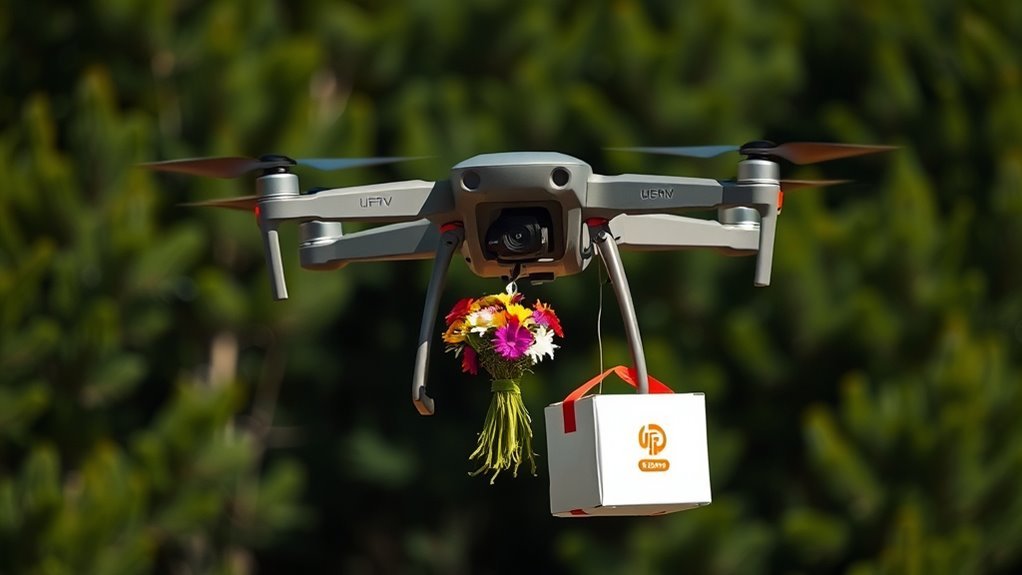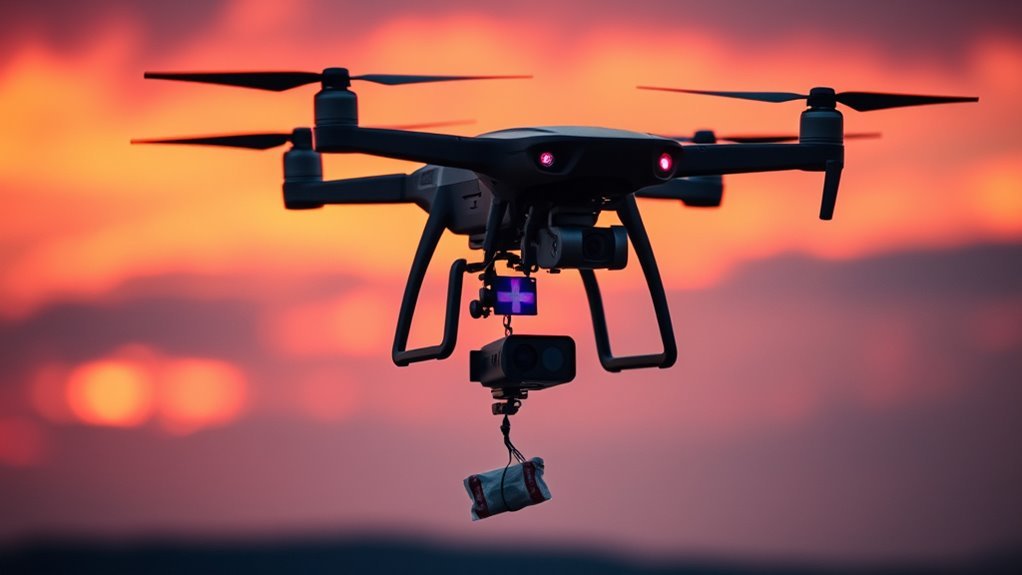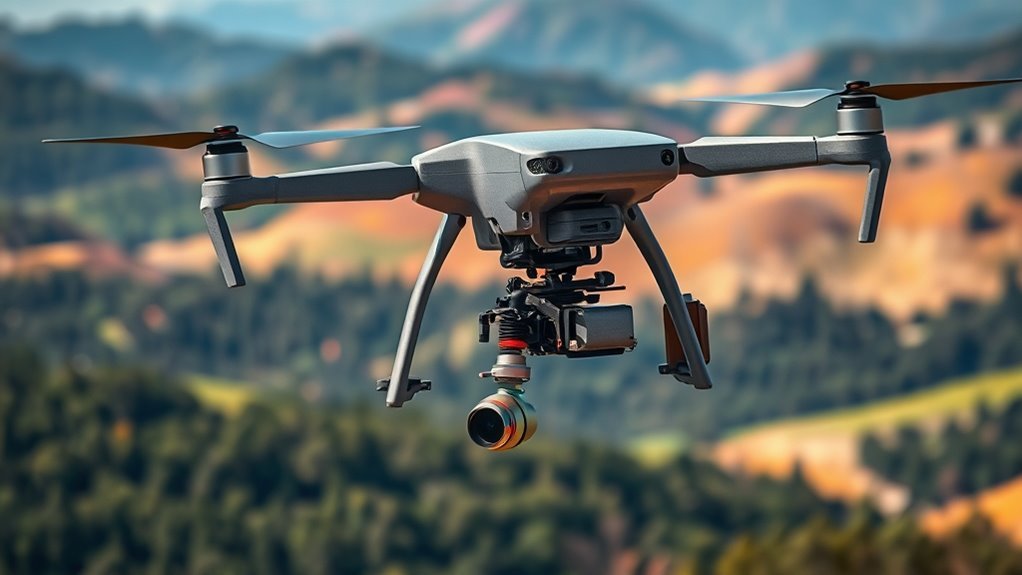Drones can carry a range of payloads, including high-resolution cameras for aerial photography, thermal imaging sensors for search and rescue, LiDAR systems for mapping, and agricultural sensors for crop monitoring. They also transport packages for e-commerce deliveries and environmental monitoring equipment. Specialized payload release mechanisms enhance delivery precision. Additionally, drones are equipped with communication devices, expanding their utility in various applications. Discover further insights into these diverse capabilities and their implications for different industries.
High-Resolution Cameras for Aerial Photography

High-resolution cameras have revolutionized aerial photography, enabling the capture of stunning images from previously inaccessible perspectives. With advancements in drone stabilization technology, you can achieve unmatched clarity and precision in your shots, regardless of environmental conditions. These cameras not only enhance visual quality but also allow for a diverse range of aerial perspectives that were once limited to manned aircraft. By integrating high-resolution sensors, you’re empowered to explore and document landscapes, urban environments, and ecological changes with unprecedented detail. The ability to capture this level of imagery provides freedom for both artistic expression and critical analysis in various fields, including environmental science and urban planning. Embracing high-resolution cameras opens up a world of possibilities in aerial photography. Additionally, drones like the Parrot Anafi AI utilize AI-driven stabilization to maintain image quality even in challenging conditions, making them particularly effective for capturing dynamic shots in various environments.
Thermal Imaging Sensors for Search and Rescue

When lives are at stake, the integration of thermal imaging sensors in drones offers a critical advantage for search and rescue operations. These sensors detect heat signatures, allowing you to identify individuals in distress, even in low visibility conditions. By employing strategic search patterns, drones can cover vast areas quickly, aiding in the efficient location of missing persons or disaster victims. The real-time data provided by thermal imaging enables rescue teams to make informed decisions, optimizing their response efforts. As you navigate complex terrains, these sensors enhance situational awareness, greatly increasing the chances of successful rescues. In time-sensitive scenarios, using drones equipped with thermal imaging can be the difference between life and death, underscoring their importance in modern rescue operations. Furthermore, the incorporation of eco-friendly design approaches in drone manufacturing supports sustainable practices while enhancing operational capabilities. The versatility of drones, such as those equipped with advanced sensors for precise detection, further contributes to their effectiveness in emergency situations.
LiDAR Systems for Mapping and Surveying

After addressing immediate life-saving needs with thermal imaging in search and rescue, the application of drones extends to advanced mapping and surveying through LiDAR systems. These systems utilize lidar technology advancements to create highly detailed, three-dimensional representations of terrain and infrastructure. By emitting laser pulses and measuring their return, drones can capture millions of data points rapidly, resulting in surveying accuracy improvements that far surpass traditional methods. This precision enables you to analyze landscapes, monitor changes over time, and make informed decisions in various fields, including urban planning and environmental management. As you explore these capabilities, you’ll appreciate how LiDAR-equipped drones empower you to harness freedom in data collection and analysis, transforming the way we comprehend our world. Additionally, drones like the Wingtra One Gen II can significantly enhance the quality of mapping data with their high-resolution imaging capabilities, which is critical for achieving sub-centimeter resolution in surveying tasks.
Agricultural Sensors for Crop Monitoring
Drones equipped with agricultural sensors can revolutionize crop monitoring by providing real-time data on plant health and soil conditions. By utilizing advanced technology, you can enhance your farming practices, ensuring maximum yields and sustainability.
- Monitor crop health through NDVI (Normalized Difference Vegetation Index) analysis, which is supported by precision crop detection technologies that offer insights into stress or nutrient deficiencies.
- Conduct detailed soil analysis to assess moisture and nutrient levels.
- Identify pest infestations and disease outbreaks early.
- Optimize irrigation and fertilizer applications based on precise data.
With these capabilities, you’ll empower yourself to make informed decisions, improving both productivity and resource management. The freedom to access actionable insights transforms traditional agriculture into a data-driven practice, ultimately benefiting both the environment and your bottom line. Embrace the future of farming with drone technology, as advanced stabilization in drones enhances the accuracy of crop monitoring results.
Delivery Packages for E-commerce and Logistics
In the domain of e-commerce and logistics, drones are increasingly recognized for their last-mile delivery capabilities, offering a potential solution to expedite package distribution. However, you’re faced with critical limitations, such as package weight restrictions and the complexities of regulatory compliance that can hinder operational efficiency. Understanding these factors is essential for optimizing drone deployment in your delivery operations. Additionally, the payload capacity of drones like the Amazon MK30 and EHang EH216-S plays a significant role in determining their suitability for various delivery scenarios. The redundant batteries and power management systems of the EHang EH216-S ensure that it can maintain reliable operations even under challenging conditions.
Last-Mile Delivery Solutions
As e-commerce continues to surge, the demand for efficient last-mile delivery solutions has become critical. Drone logistics offers a promising alternative to traditional methods, enhancing delivery efficiency and reducing transit times. Drones can navigate congested urban areas and reach remote locations, ensuring that packages arrive swiftly.
Key advantages include:
- Speed: Drones can bypass traffic, delivering packages in minutes.
- Cost-Effective: Reduced labor and operational costs streamline logistics.
- Environmentally Friendly: Electric drones lower carbon footprints compared to delivery trucks.
- Scalability: Easily deployable in various regions, adapting to demand fluctuations.
Package Weight Limitations
When evaluating package weight limitations for drone delivery, it’s essential to recognize that most commercial drones can typically carry payloads ranging from 2 to 5 kilograms (4.4 to 11 pounds). Understanding the payload capacity is vital, as it directly influences the design of the drone and the types of packages you can send.
| Drone Model | Payload Capacity |
|---|---|
| Model A | 2 kg (4.4 lbs) |
| Model B | 3 kg (6.6 lbs) |
| Model C | 4 kg (8.8 lbs) |
| Model D | 5 kg (11 lbs) |
Drones designed for heavier payloads may offer greater versatility, but you’ll need to take into account operational costs and battery life as well.
Regulatory Compliance Challenges
While traversing the complexities of regulatory compliance, e-commerce and logistics companies face significant challenges when integrating drones into their delivery systems. Steering through varying regulatory frameworks can be intimidating, often leading to compliance challenges that stifle innovation and efficiency. Understanding these hurdles is vital for successful implementation.
- Adapting to local, national, and international regulations
- Securing necessary permits and licenses
- Ensuring data privacy and security compliance
- Addressing safety and operational standards
These factors can hinder your ability to deploy drone delivery systems effectively. Balancing the desire for operational freedom with strict regulatory adherence is essential. By addressing these compliance challenges proactively, you can carve a path towards leveraging drone technology in your logistics strategy.
Medical Supplies for Emergency Response
Drones equipped to deliver medical supplies can notably enhance emergency response efforts, especially in remote or disaster-stricken areas. By optimizing drone design, you can notably streamline the supply chain, ensuring timely delivery of critical medical necessities. Here’s a concise overview of drone capabilities for medical supply delivery:
| Drone Type | Payload Capacity | Range |
|---|---|---|
| Fixed-Wing Drones | 5 kg | 100 km |
| Multirotor Drones | 2 kg | 30 km |
| Hybrid Drones | 4 kg | 70 km |
| Delivery Drones | 1 kg | 50 km |
| Emergency Drones | 3 kg | 40 km |
Utilizing drones for medical delivery not only saves time but also reduces risks associated with traditional transport methods during crises. The integration of advanced battery technology in drones like the Draganfly Vital Intelligence enhances their operational efficiency, allowing for longer missions and more reliable deliveries. Additionally, the use of AI-driven algorithms in drone navigation ensures that medical supplies reach their destination swiftly and accurately, even in challenging environments.
Environmental Monitoring Equipment
As environmental concerns rise, integrating drones equipped with environmental monitoring equipment offers a cutting-edge solution for data collection and analysis. By utilizing advanced sensor technology, these drones capture essential environmental data with unparalleled efficiency. You can monitor air quality, track wildlife populations, and assess vegetation health from vantage points previously inaccessible. This technology also aligns with precision agriculture practices, maximizing output while minimizing resource use.
- Real-time data collection
- High-resolution imaging capabilities
- Cost-effective monitoring solutions
- Enhanced data accuracy
Drones streamline the process of gathering vital information, enabling quicker responses to environmental changes. They provide researchers and policymakers with actionable insights, fostering informed decision-making. Additionally, real-time data collection ensures that environmental monitoring is both timely and effective. With the power of drone technology, you can contribute to a more sustainable future while enjoying the freedom that aerial surveillance affords.
Payload Release Mechanisms for Precision Delivery
When considering payload release mechanisms for drones, it’s crucial to understand the various types available and their specific applications. You’ll find that accuracy and safety features play a critical role in determining the effectiveness of these systems. Evaluating these aspects guarantees that payloads are delivered precisely and reliably.
Types of Release Mechanisms
Three main types of release mechanisms are commonly used for precision payload delivery: manual, automated, and programmable systems. Each has distinct advantages depending on the payload types and desired release methods.
- Manual Release: Offers full operator control, ideal for one-off deliveries.
- Automated Release: Uses sensors and algorithms for real-time decision-making, minimizing human error.
- Programmable Release: Allows for pre-set drop patterns, enhancing efficiency for repeated missions.
- Hybrid Systems: Combines elements of both manual and automated methods, providing versatility.
Selecting the right release mechanism is essential for mission success. Understanding these systems empowers you to make informed choices that align with your operational goals and desired level of control over payload deployment.
Accuracy and Safety Features
While precision in payload delivery is critical, incorporating robust accuracy and safety features into release mechanisms is equally essential. You need to guarantee that the drone’s payload accuracy is maintained, enabling precise drops even in challenging environments. Advanced GPS systems, along with real-time data analytics, can enhance positioning accuracy, minimizing the risk of misplacement. Additionally, integrating fail-safes, like automated shut-off systems, can greatly improve drone safety by preventing unintended releases. Consider the weight distribution and balance; these factors affect stability during flight and drop. By prioritizing these features, you’re not just enhancing efficiency; you’re also guaranteeing compliance with safety regulations, ultimately fostering greater freedom in drone operations and applications.
Communication Devices for Remote Connectivity
Communication devices for remote connectivity have become essential payloads for drones, enabling seamless data transmission in areas where traditional infrastructure may be lacking. These devices facilitate communication networks that allow for effective remote monitoring, ensuring that you stay connected even in the most challenging environments.
Key benefits include:
- Real-Time Data Transfer: Instantaneous updates enhance decision-making.
- Increased Coverage: Drones can reach remote areas without existing infrastructure, improving delivery efficiency in hard-to-reach locations.
- Cost Efficiency: Reduces the need for extensive ground-based networks.
- Scalability: Easily adaptable for various applications, from disaster response to environmental monitoring.
Additionally, integrating advanced AI technology into communication devices can further enhance their efficiency and reliability.
Entertainment Payloads for Events and Filmmaking
When considering entertainment payloads for events and filmmaking, aerial photography techniques offer unique perspectives that enhance visual storytelling. Additionally, light show innovations using drones can create dynamic displays that captivate audiences. Understanding these applications can greatly elevate the impact of your projects.
Aerial Photography Techniques
As filmmakers and event organizers increasingly turn to drones for aerial photography, mastering the techniques involved becomes essential for capturing stunning visuals. To elevate your aerial photography, consider these drone photography tips:
- Understand aerial composition techniques: Utilize the rule of thirds to create balanced shots.
- Experiment with angles: Unique perspectives can transform ordinary scenes into enthralling visuals.
- Plan your flight path: A well-thought-out route guarantees you capture all necessary footage without missing key moments.
- Adjust settings on the fly: Be prepared to tweak your camera settings based on changing light conditions and movement.
Light Show Innovations
While traditional light displays have captivated audiences for years, the integration of drones into light shows is revolutionizing the entertainment landscape. Drone light show technology enables precise coordination of aerial light displays, transforming how you experience events. Each drone acts as an individual pixel in a vast digital canvas, allowing for intricate designs and dynamic animations that were previously unattainable. You can now customize performances to tell unique stories, synchronize with music, and create immersive atmospheres. The agility and versatility of drones provide unprecedented freedom in artistic expression, making your events more engaging and memorable. As aerial light displays continue to evolve, they’ll certainly redefine entertainment standards and elevate audience experiences to new heights.
Frequently Asked Questions
What Are the Maximum Weights Drones Can Carry for Different Payloads?
When considering maximum payloads, you’ll find it varies considerably based on drone specifications. Some can carry a few hundred grams, while others are designed for several kilograms, enabling diverse applications across multiple industries.
How Do Weather Conditions Affect Drone Payload Performance?
Imagine sailing a kite in gusty winds—just like that, weather conditions can dramatically affect drone performance. High winds increase wind resistance, while extreme temperatures impact battery efficiency, both limiting your payload capabilities and overall flight safety.
Are There Regulations for Carrying Specific Payloads With Drones?
Yes, there’re specific regulations on payload restrictions for drones. You must guarantee legal compliance with local laws to avoid penalties. Understanding these regulations helps you maximize your operational freedom while maintaining safety and legality in your drone activities.
Can Drones Be Customized for Unique Payload Requirements?
You might think drones are limited, but their potential for payload customization is vast. With proper drone modifications, you can tailor your aircraft for specific tasks, enhancing functionality and versatility to meet unique operational needs.
What Is the Typical Battery Life for Drones Carrying Heavy Payloads?
When carrying heavy payloads, drones typically experience reduced battery efficiency, which affects flight duration. You’ll find that most can operate between 15 to 30 minutes, depending on weight and environmental conditions, impacting overall operational effectiveness.

